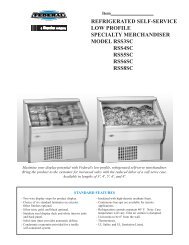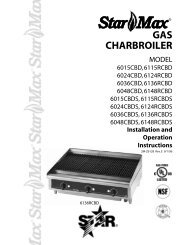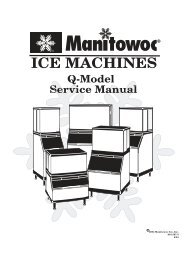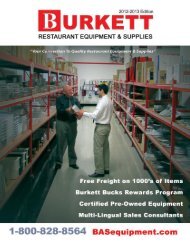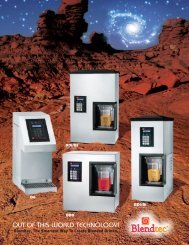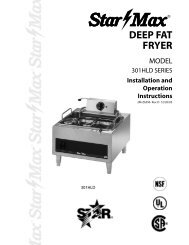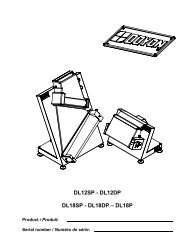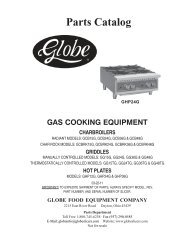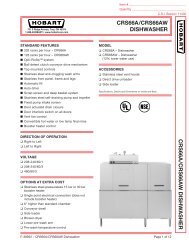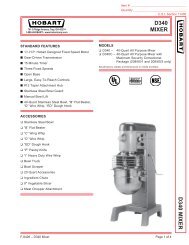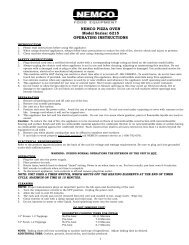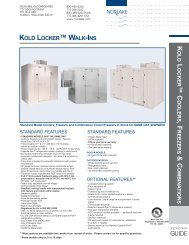- Page 1:
ManitowocQM20/QM30/QM45SM50Q130/Q17
- Page 4 and 5:
Read These Before Proceeding:! Caut
- Page 6 and 7:
Cleaning the Condenser . . . . . .
- Page 8 and 9:
Freeze Cycle Is Long, Low Ice Produ
- Page 10 and 11:
CHARTSCycle Times, 24 Hr. Ice Produ
- Page 12 and 13:
How to Read a Model NumberCube Size
- Page 14 and 15:
Model/Serial Number LocationThe mod
- Page 16 and 17:
SM50MODEL/SERIALNUMBER PLATE16 Part
- Page 18 and 19:
LaborQ130/Q170/Q210/Q2701. Labor re
- Page 20 and 21:
RESIDENTIAL WARRANTY COVERAGEWhat D
- Page 22 and 23:
How State Law AppliesThis limited w
- Page 24 and 25:
Ice Machine Clearance RequirementsS
- Page 26 and 27:
SM50/QM20/QM30After moving the ice
- Page 28 and 29:
Electrical SpecificationsQ130/Q170/
- Page 30 and 31:
QM20/QM30/QM45 Air-cooled Ice Machi
- Page 32 and 33:
COOLING TOWER APPLICATIONSWater Coo
- Page 34 and 35:
QM20/QM30LocationIce MakingWater In
- Page 36 and 37:
This Page Intentionally Left Blank3
- Page 38 and 39:
ON/OFF/WASHTOGGLESWITCHCONDENSER AI
- Page 40 and 41:
ON/OFF/WASHTOGGLESWITCHQM20 Ice Mac
- Page 42 and 43:
WATERPUMPEVAPORATORWATERSHUTTERASSE
- Page 44 and 45:
AIR-COOLED CONDENSERA dirty condens
- Page 46 and 47:
Step 1 Set the toggle switch to the
- Page 48 and 49:
D. Remove the Ice Thickness Probe
- Page 50 and 51:
Disassembly• Twist both of the in
- Page 52 and 53:
F. Remove the Float Valve• Turn t
- Page 54 and 55:
H. Remove the ice damper.Q130• Gr
- Page 56 and 57:
I. Remove the Bin Door• Grasp the
- Page 58 and 59:
Step 12 Use 1/2 of the sanitizer/wa
- Page 60 and 61:
QM20/QM30CLEANING AND SANITIZING PR
- Page 62 and 63:
Step 6 Remove parts for cleaning.A.
- Page 64 and 65:
Step 7 Mix a solution of cleaner an
- Page 66 and 67:
Step 20 Use half of the sanitizer/w
- Page 68 and 69:
4. Wait until the Clean light flash
- Page 70 and 71:
WATER SHUTTERSThe water shutter is
- Page 72 and 73:
SUMP DRAIN OVERFLOW TUBE1. Remove c
- Page 74 and 75:
SPRAY BAR, WATER PUMP AND HOSE! War
- Page 76 and 77:
! WarningWear ru bber gloves an d s
- Page 78 and 79:
WATER-COOLED ICE MACHINES1. Perform
- Page 80 and 81:
HARVEST SEQUENCE5. HarvestThe water
- Page 82 and 83:
ICE MAKINGSEQUENCE OFOPERATIONHarve
- Page 84 and 85:
HARVEST SEQUENCE4. Harvest CycleThe
- Page 86 and 87:
SM50INITIAL START-UP OR START-UP AF
- Page 88 and 89:
ENERGIZED PARTS CHARTSM50Self-conta
- Page 90 and 91:
Water Level CheckThe float valve is
- Page 92 and 93:
QM20/QM30Routine adjustments and ma
- Page 94 and 95:
5. Remove the two screws holding th
- Page 96 and 97:
Clean (Green)Pressing the “Clean
- Page 98 and 99:
This Page Intentionally Left Blank9
- Page 100 and 101:
DIAGNOSING ICE THICKNESS CONTROLCIR
- Page 102 and 103: Ice Machine Cycles Into Harvest Bef
- Page 104 and 105: INSTALLATION AND VISUAL INSPECTIONC
- Page 106 and 107: ICE FORMATION PATTERNEvaporator ice
- Page 108 and 109: SAFETY LIMIT FEATUREIn addition to
- Page 110 and 111: Safety Limit Notes• A safety limi
- Page 112 and 113: Safety Limit ChecklistThe following
- Page 114 and 115: Safety Limit #2Harvest time exceeds
- Page 116 and 117: Discharge Pressure High ChecklistIm
- Page 118 and 119: ProcedureStep1. Determine the ice m
- Page 120 and 121: Suction Pressure Low ChecklistImpro
- Page 122 and 123: Hot Gas Valve AnalysisThe valve can
- Page 124 and 125: FindingsThe inlet of the harvestval
- Page 126 and 127: DISCHARGE LINE TEMPERATURE ANALYSIS
- Page 128 and 129: REFRIGERATION COMPONENT DIAGNOSTICC
- Page 130 and 131: FINAL ANALYSISThe column with the h
- Page 132 and 133: Q130/Q170/Q210/Q270 Ice Machines On
- Page 134 and 135: QM20/QM30DIAGNOSING AN ICE MACHINET
- Page 136 and 137: QM30The QM30 ice machines have a ve
- Page 138 and 139: Ice Production CheckThe QM20/QM30 d
- Page 140 and 141: REFRIGERATION DIAGNOSTICSImportant:
- Page 142 and 143: 5. Install thermometer thermocouple
- Page 144 and 145: SM50DIAGNOSING AN ICE MACHINETHAT W
- Page 146 and 147: ICE QUALITY IS POOR — CUBES ARE S
- Page 148 and 149: ICE MACHINE RUNS AND NO ICE IS PROD
- Page 150 and 151: DISCHARGE PRESSURE HIGH CHECKLISTIm
- Page 154 and 155: Other• Non-Manitowoc components i
- Page 156 and 157: FindingsThe inlet of the harvestval
- Page 158 and 159: ADJUSTING CUBE WEIGHTThe cube weigh
- Page 160 and 161: Bin SwitchQM45/Q130/Q170/Q210/Q270F
- Page 162 and 163: Bin Switch Removal — QM45/Q1301.
- Page 164 and 165: Bin ThermostatQM20/QM30FunctionThe
- Page 166 and 167: SM50FunctionThe bin thermostat stop
- Page 168 and 169: Check Procedure! WarningHigh (line)
- Page 170 and 171: Temperature/Resistance ChartAs the
- Page 172 and 173: ON/OFF/WASH Toggle SwitchFUNCTIONTh
- Page 174 and 175: Ice Thickness ProbeQM45/Q130/Q170/Q
- Page 176 and 177: Compressor Electrical DiagnosticsTh
- Page 178 and 179: Fan Cycle ControlQM45/Q130/Q170/Q21
- Page 180 and 181: Filter-DriersLIQUID LINE FILTER DRI
- Page 182 and 183: REFRIGERANT RE-USE POLICYManitowoc
- Page 184 and 185: RECOVERY AND RECHARGING PROCEDURESQ
- Page 186 and 187: NOTE: Manifold gauges must be remov
- Page 188 and 189: ImportantManifold gau ges must be r
- Page 190 and 191: System Contamination CleanupGENERAL
- Page 192 and 193: MILD SYSTEM CONTAMINATION CLEANUPPR
- Page 194 and 195: REPLACING PRESSURE CONTROLS WITHOUT
- Page 196 and 197: Q270 Condenser Fan Motor Replacemen
- Page 198 and 199: MAX. 1300°F(700°C)SV30714. Apply
- Page 200 and 201: High Pressure Cutout (HPCO) Control
- Page 202 and 203:
This Page Intentionally Left Blank2
- Page 204 and 205:
QM20 SELF-CONTAINED AIR-COOLEDNOTE:
- Page 206 and 207:
QM45 SELF-CONTAINED AIR-COOLEDNOTE:
- Page 208 and 209:
SM50 SELF-CONTAINED AIR-COOLEDNOTE:
- Page 210 and 211:
Q130 SELF-CONTAINED AIR-COOLED(Afte
- Page 212 and 213:
Q170 SELF-CONTAINED AIR-COOLEDNOTE:
- Page 214 and 215:
Q210 SELF-CONTAINED WATER-COOLEDNOT
- Page 216 and 217:
Q270 SELF-CONTAINED WATER-COOLEDNOT
- Page 218 and 219:
QM20CAUTION: DISCONNECT POWER BEFOR
- Page 220 and 221:
QM30230V/1 Ph/50 HzL1CAUTION: DISCO
- Page 222 and 223:
SM50L1CAUTION: DISCONNECT POWER BEF
- Page 224 and 225:
Q130/Q170/Q210Danfoss CompressorL1N
- Page 226 and 227:
Q270Danfoss CompressorL1NOTE: DIAGR
- Page 228 and 229:
QM45/Q130/Q170/Q210/Q270ICE THICKNE
- Page 230 and 231:
Tubing SchematicsQM20/QM30 Tubing S
- Page 232 and 233:
SM50 Tubing SchematicHEATEXCHANGERE
- Page 234:
This Page Intentionally Left Blank2




